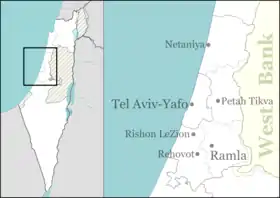Yehud attack
The Yehud attack was an attack on a civilian house in the village of Yehud carried out by a Palestinian fedayeen squad on 12 October 1953. Three Israeli Jewish civilians were killed in the attack.
| Yehud attack | |
|---|---|
| Part of Palestinian Fedayeen insurgency | |
 Attack site | |
| Location | Yehud, Israel |
| Date | 12 October 1953 |
Attack type | guerrilla attack |
| Deaths | 3 |
| Perpetrators | Palestinian Fedayeen squad |
The attack
On Monday, 12 October 1953, a Palestinian Fedayeen squad infiltrated into Israel from Jordan. The militants reached the Jewish village Yehud, located about 13 kilometers (8 mi) east of Tel Aviv, where they threw a grenade into a civilian house.[1]
A Jewish woman, Suzanne Kinyas, and her two children (a 3 year old girl and a 1 and a half year old boy) were killed.[1]
The tracks of the perpetrators led to the Palestinian village of Rantis, then under the control of Jordan, located about five miles north of Qibya.[2]
The attack shocked the Israeli public, both because it was the first terror attack committed in the center of Israel and because the victims of the attack were a woman and her infant children, who were killed in their sleep.[2]
Israeli retaliation
Although the Commander of the Arab Legion (as the Jordanian Armed Forces were known at the time), Glubb Pasha, promised that Jordan would catch the perpetrators and bring them to justice, on the morning of 13 October a decision was made by the Israeli Prime Minister David Ben-Gurion, and the Chief of Staff Mordechai Maklef, deputy chief of staff Moshe Dayan and acting defense minister Pinhas Lavon, of retaliation in response to the Yehud attack.[3] About 130 IDF soldiers participated in the reprisal codenamed Operation Shoshana (after the three-year-old girl killed in the Yehud attack), which was commanded by Ariel Sharon. The IDF force arrived at the village of Qibya, threw grenades and fired through the windows and doors of the houses. Then blew up 45 houses, a school, and a mosque. About 60 civilians, mostly women and children, were killed.[4]
The act was condemned by the U.S. State Department, the UN Security Council, and by Jewish communities worldwide.[3]
References
- Byman, Daniel (2011). A High Price: The Triumphs and Failures of Israeli Counterterrorism. Oxford University Press. p. 22. Retrieved 14 October 2014.
- Becker, Avihai (8 January 2003). "They Were Three". Haaretz.
- Avi Shlaim (2001). The Iron Wall: Israel and the Arab World. W. W. Norton & Company. p. 91. ISBN 0-393-32112-6. Avi Shlaim writes: "The Qibya massacre unleashed against Israel a storm of international protest of unprecedented severity in the country's short history."
- Benny Morris, Israel's Border Wars, 1949-1956: Arab Infiltration, Israeli Retaliation and the Countdown to the Suez War, Oxford University Press, 1993, pp. 258-9.
External links
- Jordan lets Israelis track killer of 3 - Published on The New York Times on 14 October 1953